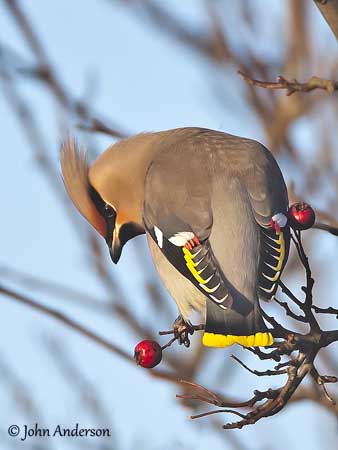
FAMILY BOMBYCILLIDAE
Waxwings
This small family includes only three closely related species. But in spite of several shared traits such as backward-pointing crest, black mask, chin and throat, peculiar markings on primaries and secondaries, greyish-brown plumage, paler underparts with contrasting undertail-coverts, and brightly coloured terminal tail band, these three species show some physical differences.
From some observations, it appears that Japanese Waxwing (Bombycilla japonica) and Bohemian Waxwing (Bombycilla garrulus) are closely related, whereas the Cedar Waxwing (Bombycilla cedrodum) is somewhat more distantly related. They have almost similar body size with a length of about 18 centimetres.
However, both Bohemian and Cedar Waxwings show wax-like red tips on secondaries, indicating some relationship between them, whereas the Japanese Waxwing rarely has this type of small red tips. This trait has probably been lost in this species.
Text by Nicole Bouglouan
Photographers:
John Anderson
John Anderson Photo Galleries
Steve Garvie
RAINBIRDER Photo galleries
Tom Grey
Tom Grey's Bird Pictures
René Lortie
http://rlortie.ca/
Ingo Waschkies
Bird Photography
Sources:
HANDBOOK OF THE BIRDS OF THE WORLD Vol 10 by Josep del Hoyo-Andrew Elliott-David Christie - Lynx Edicions - ISBN: 8487334725
BirdLife International (BirdLife International)
CREAGUS@Monterey Bay (Don Roberson)
Ornithomedia - Le Web de l’Ornithologie
Wikipedia, the free encyclopaedia

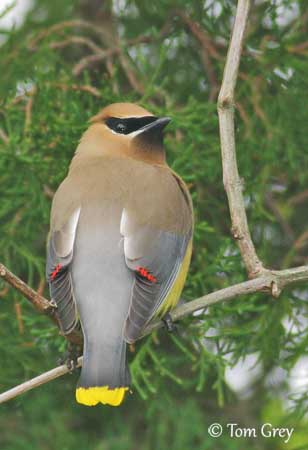
Waxwings have acquired their English name from these red wax-like appendages which adorn the secondaries. They are an extension of the feather shaft. These flattened appendages are similar to elongated teardrops, and their red colour is due to a carotenoid pigment. The number of these red wax-like tips depends on the species, but in the case of the Japanese Waxwing, this trait is often lacking and replaced by bright red or pink spots.
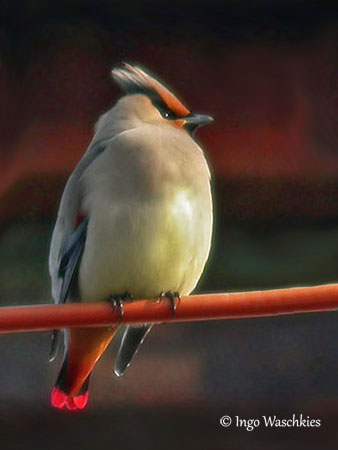
Bombycilla japonica
In all species, both sexes are similar. The female is slightly duller with reduced or duller pattern, as well on wings as on head, chin and throat.
The juvenile is much duller than adults. It has shorter crest, it lacks chin and throat black patch, and has reduced facial mask. Underparts are paler, often whitish or pale buffy-white, with conspicuous darker streaks. It usually lacks the wax-like red tips on secondaries, or only has a few small ones.
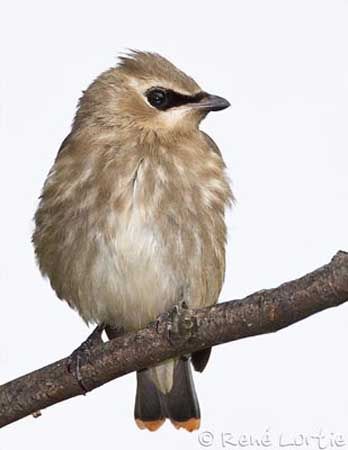
Waxwings breed in forests, deciduous for the Cedar Waxwing, and coniferous for Bohemian Waxwing and Japanese Waxwing. But that depends on tree species and predominant forest types found in each breeding range. They also need fruiting trees and bushes close to their nesting sites or included within it.
But during the winter months, they frequent broader type of habitats. They occur in forests, but also in urban areas such as parks and gardens where there are available fruits on trees and other plant species. All three species feed heavily on sugary fruits mainly in autumn and winter, while arthropods are taken mostly during summer. They feed primarily on berries and insect during the breeding season, but also fruits, flowers, tree sap, buds and blossoms.
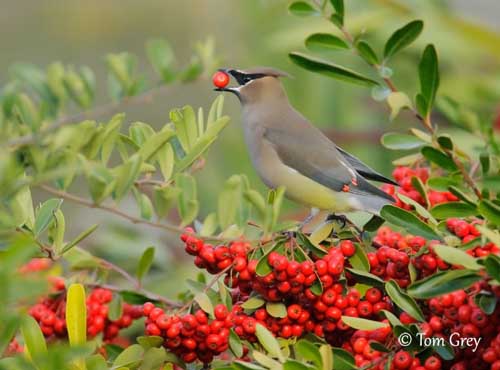
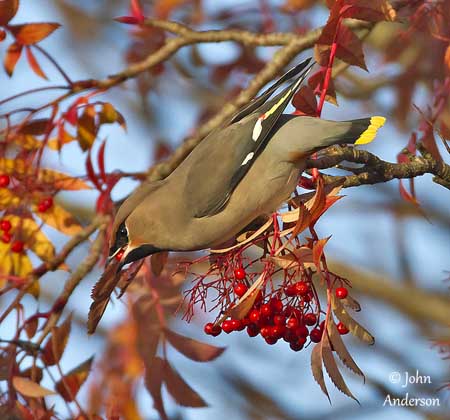
Bombycilla cedrodum
Bombycilla garrulus
They are sometimes considered pest because a flock of waxwings can remove all buds or fruits of a tree in a few hours or even in a few minutes!
Insects are caught by sallies and aerial flycatching, and fruits and berries by gleaning in trees and bushes, often perching upside-down to reach some fruit at the end of a small branch. They are very agile and cling to twigs and branches, but they only perform short hops on the ground where they come only for bathing, drinking or taking fallen fruits.
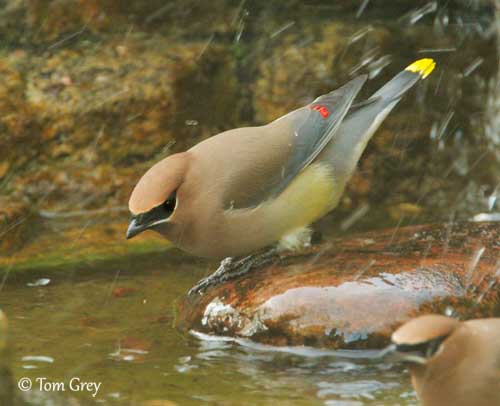
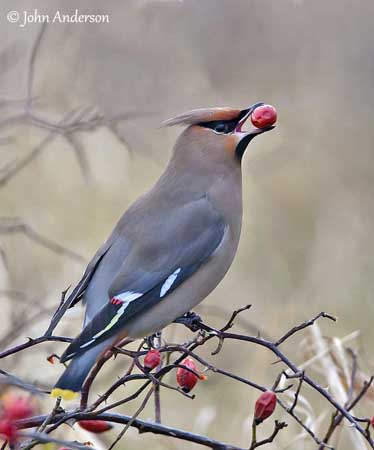
Bombycilla cedrodum
Bombycilla garrulus
Waxwings are gregarious birds outside the breeding season, and form large flocks, from 200-1000 and up to 3000 Bohemian Waxwings, about 100 Cedar Waxwings, and only up to 50 Japanese Waxwings.
They roost together in dense trees, hedges or other sheltered places during winter, whereas they prefer sites near water in spring and early summer, where they can find numerous insects. But in very cold weather, they may roost in contact with each other to keep them warm.
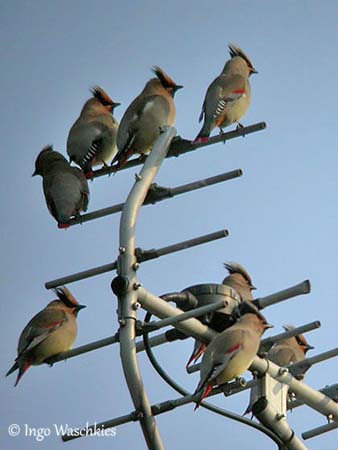
Bombycilla japonica
They are quite vocal and utter high-pitched whistles and trilled call notes. Other calls are variations of these sounds, but during nest-building and courtship, pairs may produce soft buzzing trills. Fledglings give loud and intense variants of these calls. According to each species, calls and whistles may vary in pitch, with shorter or longer series of notes.
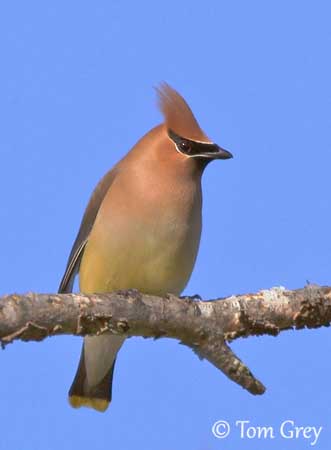
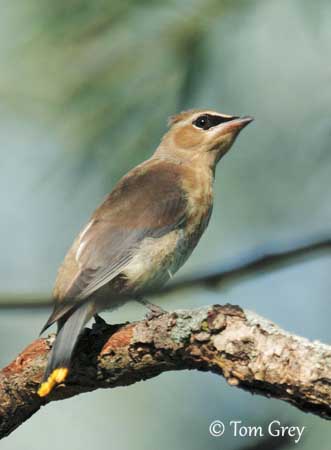
Voice of Bohemian Waxwing : SOUNDS BY XENO-CANTO
Voice of Cedar Waxwing : SOUNDS BY XENO-CANTO
Aggressive encounters are very rare in waxwings flocks, even during courtship or nesting periods. The large flocks allow the waxwings to defend a food source such as a fruiting tree, but larger birds may sometimes chase or even kill some of them.
Waxwings usually breed later than other species. They largely depend on fruit during the breeding season, for them and to feed their young. The egg-laying often starts in early to mid-June. Pairs form earlier, and courtship displays have been observed in winter flocks as early as late November, but this behaviour often lasts into late June.
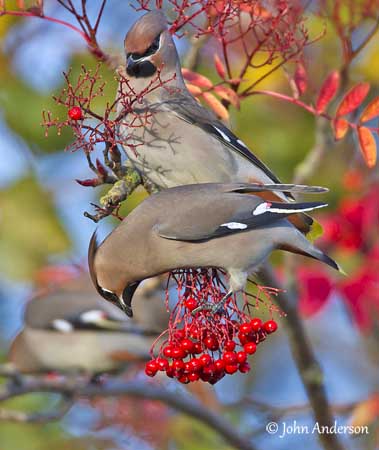
Bombycilla garrulus
Typical courtship displays show male and female exchanging food. A bird holds the food in its bill, and hops away before to return to the side of the partner. This “courtship-hopping” or “gif-passing-ceremony” is often initiated by the male. Sometimes, the exchange of food is simulated and the birds only touch their bills. This display ends when one of the birds (often the female) consumes the food. Copulation usually follows this display.
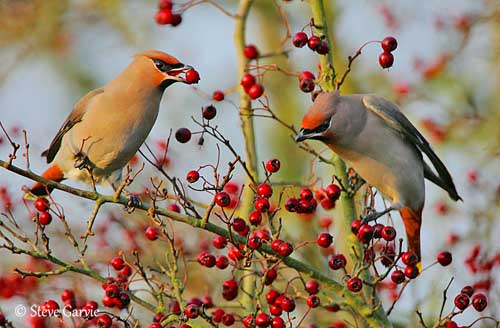
Bombycilla garrulus
During the displays, the crest is raised to enhance the reddish colour of the crown contrasting with the black mask, and the grey rump feathers are fluffed.
The male guards the female against rivals and keeps them away from her while the laying is approaching. Threats and short chases may occur during this period. The male adopts an upright posture or leans forwards with the bill open.
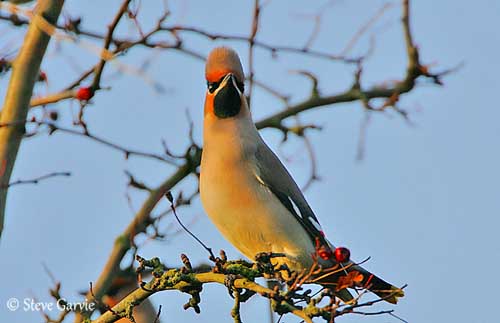
Bombycilla garrulus
Waxwings are monogamous, at least seasonally. They do not defend a breeding area, but the male performs mate-guarding. They need to defend the nest against conspecifics, because they often steal nest materials in active nests of other birds but of their own species too. However, they tolerate other waxwings near the nest, and sometimes, several pairs may nest close to each other within the same area. But most of them nest solitary.
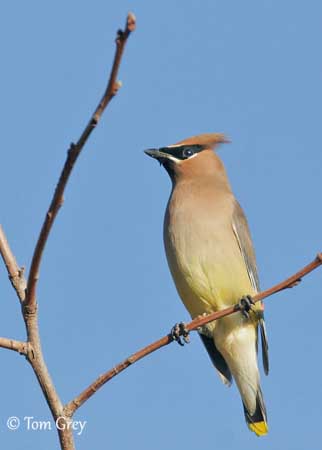
Bombycilla cedrodum
Both sexes build the nest, an open cup made with twigs, grasses and roots. The Japanese Waxwing prefers larch twigs, whereas the Cedar Waxwing incorporates some items such as string and other artificial material, and decorates the nest with flowers which dangle below the cup. The Bohemian Waxwing covers the outer part of the nest with lichens, and lines the inner cup with feathers and fur.
The three species nest in trees, at heights ranging between 8-10 and 1-15 metres, but most nests are placed at about 4 metres above the ground.
The clutch size appears to be five (2-6) bluish-grey eggs, with sparse darker markings. The female incubates alone, but she is fed by the male during this period. Incubation lasts between 12 and 14 days, and the chicks are fed by both parents. They leave the nest 14-18 days after hatching, according to weather conditions and disturbances at nest. The young birds are still fed by parents during 6-10 days, but they are able to feed themselves three days after leaving the nest.
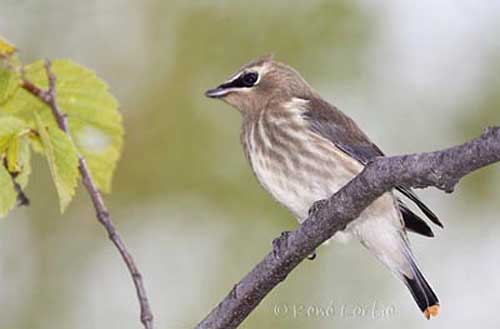
The breeding and nesting behaviour of the Japanese Waxwing is poorly known, but from some observations, we can suggest that its behaviour is similar to that of other waxwings.
Waxwings have pointed wings allowing them fast flight with steady wingbeats. They perform direct flight on short distances, whereas over longer distances, wingbeats are interspersed with glides, but the flight is not deeply undulating.
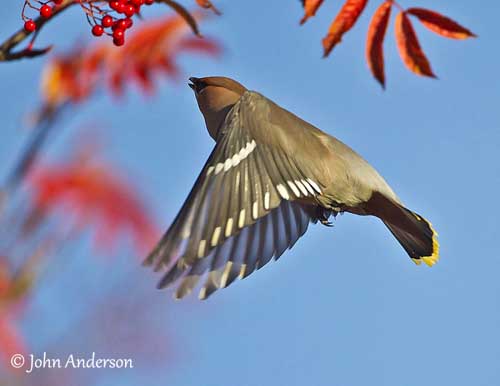
Bombycilla garrulus
They are known for their irruptions, with large flocks in unusual areas. They migrate over short to moderate distance, travelling in conspicuous flocks during the day. But some nocturnal flights might occur too.
They are erratic and wander largely after the nesting period, instead to remain in the same area during the whole winter. They depend on food sources, and especially fruits and berries, and travel in order to find available fruiting plant species. This behaviour explains their irruptions in areas where they can feed, but maybe the hard weather conditions in northern regions may also play a role in these large movements.
The Bohemian Waxwing breeds in northern parts of Eurasia and North America, and migrates southwards in winter, often irregularly according to the years. This species is not threatened with stable populations and even some increase.
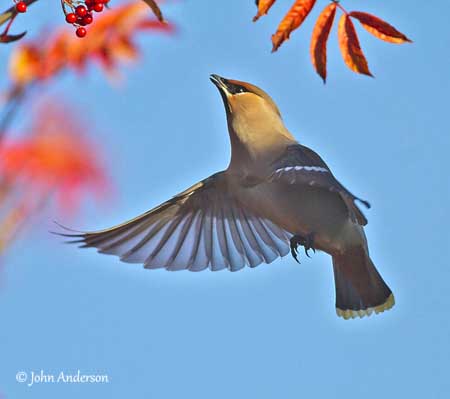
Bombycilla garrulus
The Cedar Waxwing breeds in northern parts of North America, and migrates southwards to Costa Rica during winter. This species is not threatened and populations are stable or increasing.
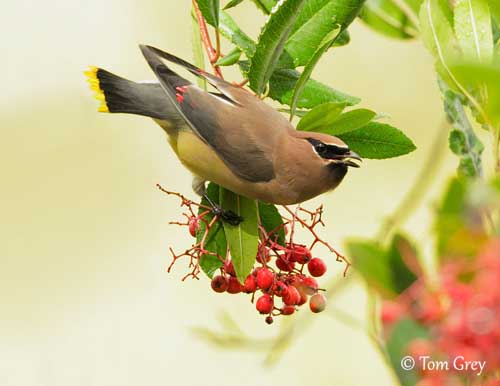
Bombycilla cedrodum
The Japanese Waxwing breeds in SE Russia and irregularly in NE China. It spends the winter in E China, Korea and Japan. This species is considered Near Threatened, with small populations in restricted range. Changes in its habitat and use of pesticides may affect this species.
Waxwings are particularly attractive for humans. They are occasional visitors, and when large numbers invade unusual regions farther south, many birdwatchers, media and nature-lovers are attracted by these beautiful birds which feed on berries in trees and bushes in urban parks and gardens.
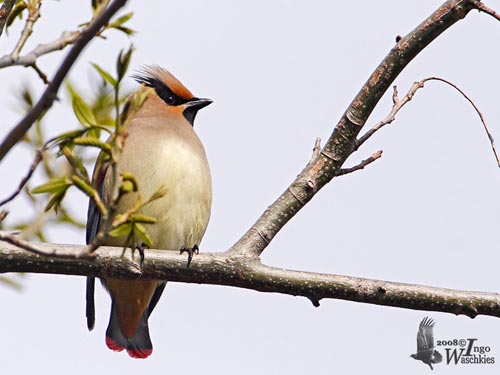
Bombycilla japonica